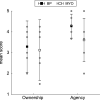Differential experiences of embodiment between body-powered and myoelectric prosthesis users
- PMID: 32963290
- PMCID: PMC7508812
- DOI: 10.1038/s41598-020-72470-0
Differential experiences of embodiment between body-powered and myoelectric prosthesis users
Abstract
Prosthesis embodiment, the perception of a prosthesis as part of one's body, may be an important component of functional recovery for individuals with upper limb absence. This work determined whether embodiment differs between body-powered and myoelectric prosthesis users. In a sample of nine individuals with transradial limb absence, embodiment was quantified using a survey regarding prosthesis ownership and agency. The extent to which the prosthesis affected the body schema, the representation of the body's dimensions, was assessed using limb length estimation. Because body-powered prostheses offer proprioceptive feedback that myoelectric prostheses do not, it was hypothesized that both measures would reveal stronger embodiment of body-powered prostheses. However, our results did not show differences across the two prosthesis designs. Instead, body schema was influenced by several patient-specific characteristics, including the cause of limb absence (acquired or congenital) and hours of daily prosthesis wear. These results indicate that regular prosthesis wear and embodiment are connected, regardless of the actual prosthesis design. Identifying whether embodiment is a direct consequence of regular prosthesis use would offer insight on how individuals with limb absence could modify their behavior to more fully embody their prosthesis.
Conflict of interest statement
The authors declare no competing interests.
Figures




References
-
- Scarry E. The merging of bodies and artifacts in the social contract. In: Bender G, Druckey T, editors. Culture on the Brink: Ideologies of Technology. Toronto: Bay Press; 1994. pp. 85–97.
-
- McDonnell PM, Scott RN, Dickison J, Theriault RA, Wood B. Do artificial limbs become part of the user? New evidence. J. Rehabil. Res. Dev. 1989;26:17–24. - PubMed
Publication types
MeSH terms
LinkOut - more resources
Full Text Sources
Medical

